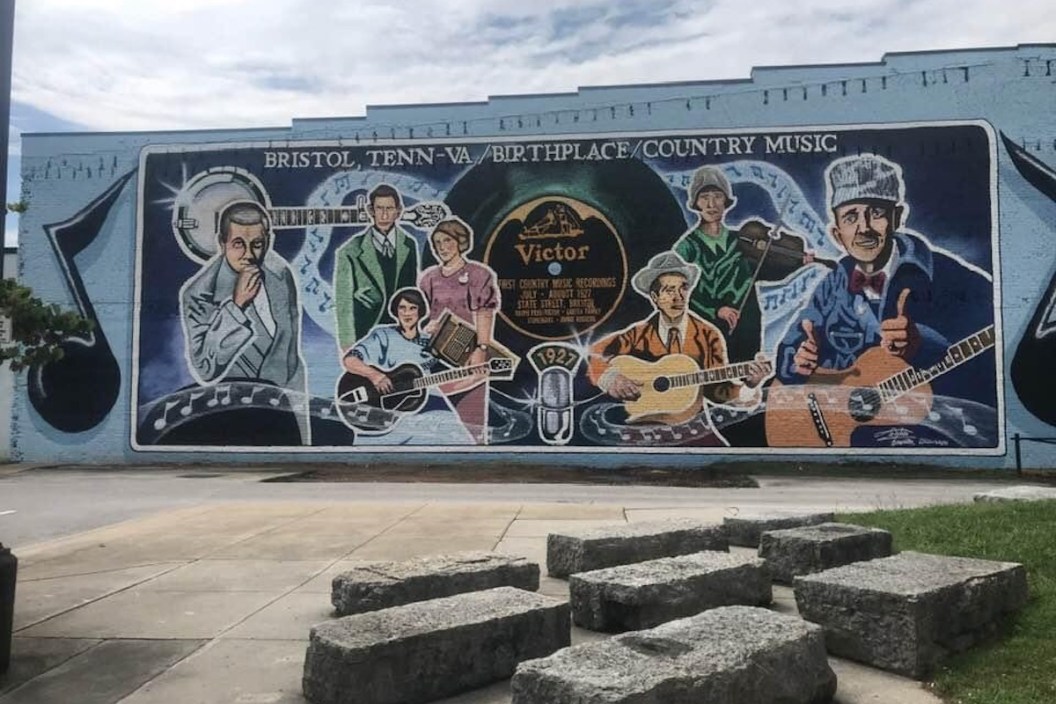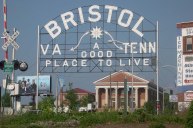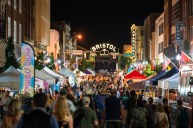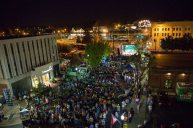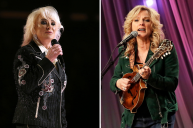Folks on both sides of Bristol, a twin city on the Tennessee and Virginia line, take pride nowadays in country music's "big bang" moment from 1927. Music tourism drives not just the annual Bristol Rhythm & Roots Reunion festival (held this year on Sept. 10-12) but also the Birthplace of Country Music Museum, which chronicles how RCA Victor's Ralph Peer hosted local recording sessions that exposed foundational country acts the Carter Family, the Stoneman Family and Jimmie Rodgers to the masses.
Before Bristol officials boosted both cities' economies by shifting popular music history to the forefront, local banjo picker Tim White took it upon himself in the mid-'80s to design and paint the Birthplace of Country Music Mural (or the Bristol Country Music Mural, depending on who's hashtagging their obligatory selfie).
"At that point in time, there was some embracing of our country music heritage, but it wasn't like it is now," White told Wide Open Country. "I'm glad to see it like it is now. I got their okay to do it because I had to get their permission because it was so large. I went to a City Council meeting and they approved it, and they wouldn't fund it. I couldn't get the Chamber to help me raise money, so I did it basically out of my own pocket."
White designed the mural in 1985 and completed it the following year with paint donated by a local business.
"I'm originally from Roanoke, Va. and moved down here as a young man and started playing the banjo," White said. "I learned about the Carter Family and Jimmie Rodgers and the Stonemans, the ones that are on that mural. I thought, 'Why isn't this a big-time splash for the city of Bristol?' So it's just something I wanted to do. I had the sign shop, Tim White Signs. I had the know-how on how to paint a mural, and I had the enthusiasm that I love the music so much. I had the enthusiasm to say, 'I'm going to do this thing.' In 1986, I set up scaffolding. I was a lot younger and lighter back then. I climbed it on scaffolding, and I'd designed it. It took me about a year in my spare time to design. I've still got the original canvas here at home."
The mural became part of the twin cities' collective image once they began embracing the legacy of the Bristol Sessions.
"In '86, a lot of people looked down their nose. 'We've tried that country music stuff. It don't work.' I knew they were wrong. They just hadn't tried it the right way," White added. "This past year in 2020, the city funded the repainting of the mural. It started to fade. Sunlight fades your paint. They even went as far as to do repairs on the wall and clean it for me. The city of Bristol, Tenn. funded it this time because even the cops that walk the beat downtown, they told me many times, they say, 'You wouldn't believe that practically every day, tourists are stopping here to get their picture made in front of your mural.' I knew that this would happen in 1986. I really did. I'm not bragging. I'm just telling you, I knew in my heart or hearts that this would work, and it has in a big way."
Descendants of the Carter Family attended the mural's unveiling in '86, and later on, Pops and Hattie Stoneman's daughter Patsy had to see for herself the painting of her parents that had gotten a rave verbal review by Charlie Daniels.
"We got to be dear friends with Patsy, me and my wife Penny," White explained. "She said, 'I'm not going to give up on getting Daddy into the Hall of Fame. If somebody thought enough of Mom and Daddy to put them on that big ole wall, I'm not going to quit.' And lo and behold, back in 2008, they put her daddy in the Hall of Fame posthumously."
Soon after White completed his masterpiece, his fellow country, old-time and bluegrass pickers started using it as a backdrop for impromptu jams.
"There was a gentleman here in town. His name was Gene Boyd, and he owned a barbershop," explained former city official Terri Talbert. "They called him the 'Fiddlin' Barber.' There was even a nationally syndicated cartoon that was in the newspaper, and Gene was part of that one time because the gentleman who wrote it came through Bristol. Anyway, he had a really colorful history, and he and a man by the name of Ken Morrell... His whole family is super talented. And then a gentleman by the name of Hal Boyd, who owned a bicycle shop here in town. To be quite frank with you, you can't throw a rock without hitting somebody that has amazing talent in this area. But anyway, those three and some others would go down to the mural, drag out their instruments and if they had a little sound system, they'd hook it up. Some nights they didn't. They would sit there in front of the mural and had a jam session.
"We had a pizza company that was just starting out, and they'd come down, set up a pizza truck and sold pizzas and soft drinks," Talbert continued. "And they would jam for a couple of hours. It was the neatest thing in the world. Everyone brought their lawn chairs, and it was a grassroots thing."
Before the mural became a tourism centerpiece on State Street, it served as a rallying point for talented (and fairly paid) Appalachian musicians that, like White, wanted to draw more attention to the area's role in shaping the music that'd later make Nashville famous.
"When we started concentrating on having music downtown, we realized those people were not getting paid a dime," Talbert said. "They did it for the love of music. So our department decided to try to organize it a little more. Because we had the Civic Center, we had thousands of chairs. We had a very big sound system, but we also had a smaller one we used. So we got together with all of the musical groups and started paying. They were delighted, and I'm a great believer in starving artists shouldn't really be starving. When you are an artist, that should be recognized as a work. So anyway, we set up a pay, and everybody got the same scale. We set up chairs every Tuesday and Thursday from May through October."
Read More: Kathy Mattea Named New Host of NPR's 'Mountain Stage'
White's contributions to Bristol's image go beyond the mural and include his role in co-founding the Birthplace of Country Music Alliance and his hosting gig on PBS' Song of the Mountains.
The Birthplace of Country Music Mural is located in a public square at 810 State St. It's one of the main stages for this weekend's Bristol Rhythm & Roots Reunion festival.
